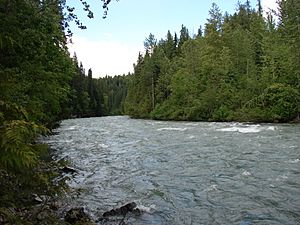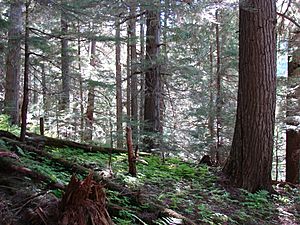Goat River (Fraser River tributary) facts for kids

The Goat River is a beautiful river in British Columbia, Canada. It's a branch of the larger Fraser River. The Goat River starts high up in the Cariboo Mountains. It flows east and northeast to join the Fraser River near a small town called Crescent Spur. This area is known as the Robson Valley.
The Goat River and its main branch, the Milk River, cover a large area of about 66,468 hectares. Other important streams that flow into the Goat River include McLeod, North Star, Whitehorse, Quartz, Diggings, and Kendall creeks.
Contents
History of the Goat River Valley
The valley of the Goat River was once a very important travel route. First Nations people used it to move between the Robson Valley and the forested areas around the Bowron Lakes.
Gold Rush and Railway Era
After the Cariboo Gold Rush started, a special trail was opened along this old route. This trail helped connect the goldfields with the Fraser River. A person named Robert Buchanan explored and mapped this trail. He is the one who gave the river its current name, Goat River.
Later, this trail was used to bring supplies to the workers building the Grand Trunk Pacific Railway. This railway was being built through the Robson Valley. After the railway was finished, people stopped using the old trail.
Modern Times and Conservation Efforts
The area remained mostly quiet until the 1980s. That's when companies started logging trees in the river valley. A road was built along the lower river and into the Milk River valley.
In 1998, a group called the Fraser Headwaters Alliance started working to protect the area. They are based in Dunster. This group was against more logging in the river's watershed. To show how beautiful the area was, they built a major hiking trail.
Between 1998 and 2000, a logging company built a new bridge and road into the upper river valley. They wanted to cut down trees there. However, local groups strongly opposed these plans. Also, it was very expensive to get to the upper river. Because of this, the logging company eventually stopped its plans in the early 2000s.
Ecology of the Goat River
The Goat River has clear and cool water. Its warmest temperature in a year is about 8°C (46°F). This river is home to several types of fish.
Fish and Aquatic Life
The river supports populations of bull trout and chinook salmon. These fish use the river's gravel beds as places to lay their eggs. This process is called spawning. Mountain whitefish also live in the Goat River.
The Milk River is fed by glaciers. This means it carries tiny rock particles and mud, called "rock flour" and "sediment," into the lower Goat River. However, the upper Goat River is not fed by glaciers. Its water is exceptionally clear before it joins the Milk River.
Wildlife and Habitats
The Goat River watershed is a home for many large mammals. These include grizzly bears, mountain goats, wolverines, and wolves. Caribou also travel through this area. You can find many caribou in some of the smaller streams that flow into the Goat River, especially McLeod Creek.
Forests and Plants
The Goat River and nearby valleys are mostly covered by coniferous forests. These are forests with trees like pines and firs that have needles. The area has four different biogeoclimatic zones. These zones describe areas with similar climates and plant life.
In the lower river valley, you'll find wet interior cedar-hemlock forests. These include very old and large western red cedar trees. The Engellmann spruce-subalpine fir zone covers most of the rest of the area. Along the river's edge, you can also see trees that lose their leaves in the fall. A common plant covering the ground in the valley is called devil's club.
Some parts of the lower Goat and Milk River watersheds have been changed by human activities. These include mining and logging. A logging road follows the lower river and then goes into the Milk River area. However, the upper river is almost completely untouched. It has the second largest area of unprotected old-growth forest in the Robson Valley region. The Raush River watershed to the south has the largest.
Recreation in the Goat River Area
The old travel route through the Goat Valley has been restored for fun activities. The Fraser Headwater Alliance group reopened it as a hiking trail in 1998.
Hiking and Trails
About 91 kilometers (57 miles) of trail were opened between the Robson Valley and the Bowron Lakes. This trail is part of a bigger network of trails across the country. It connects with the Alexander MacKenzie Heritage Trail and the Gold Rush Pack Trail. The part of the trail along the Goat River includes crossing several streams. There's also a cable car that helps people cross the Milk River.
Other Outdoor Activities
The river is also popular with people who enjoy kayaking. In the winter, Heli-skiing takes place on the high slopes above the upper river. This is where skiers are taken to mountain tops by helicopter.



